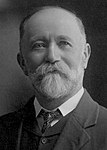
The Australian Labor Party (ALP), also simply known as Labor, is the major centre-left political party in Australia, one of two major parties in Australian politics, along with the centre-right Liberal Party of Australia. It has been in Opposition in the federal parliament since the 2013 election. The ALP is a federal party, with political branches in each state and territory. They are currently in government in Victoria, Queensland, Western Australia, South Australia, the Australian Capital Territory, and the Northern Territory. The Labor Party is the oldest political party in Australia.
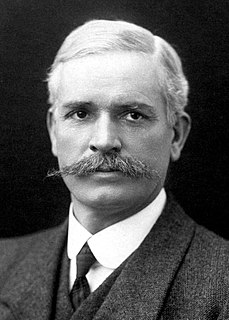
Andrew Fisher was an Australian politician who served three terms as prime minister of Australia – from 1908 to 1909, from 1910 to 1913, and from 1914 to 1915. He was the leader of the Australian Labor Party (ALP) from 1907 to 1915.

John Christian Watson was an Australian politician who served as the third prime minister of Australia, in office from 27 April to 18 August 1904. He served as the inaugural federal leader of the Australian Labor Party (ALP) from 1901 to 1907 and was the first member of the party to serve as prime minister.
The Protectionist Party or Liberal Protectionist Party was an Australian political party, formally organised from 1887 until 1909, with policies centred on protectionism. The party advocated protective tariffs, arguing it would allow Australian industry to grow and provide employment. It had its greatest strength in Victoria and in the rural areas of New South Wales. Its most prominent leaders were Sir Edmund Barton and Alfred Deakin, who were the first and second prime ministers of Australia.
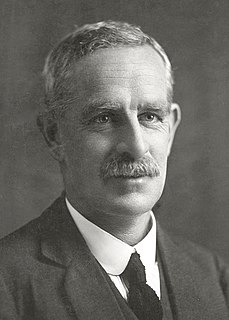
Francis Gwynne Tudor was an Australian politician who served as the leader of the Australian Labor Party from 1916 until his death. He had previously been a government minister under Andrew Fisher and Billy Hughes.
The Liberal Party was a parliamentary party in Australian federal politics between 1909 and 1917. The party was founded under Alfred Deakin's leadership as a merger of the Protectionist Party and Anti-Socialist Party, an event known as the Fusion.

Gregor McGregor was an Australian politician who served as a Senator for South Australia from 1901 until his death in 1914, representing the Labor Party. He was the party's inaugural Senate leader, and served three terms as Leader of the Government in the Senate.

William Robert Nuttall Maloney was an Australian doctor and politician. He was a member of parliament for over 50 years, beginning his career in the Victorian Legislative Assembly as the member for the seat of West Melbourne (1889–1903). He was elected to the federal House of Representatives at the 1904 Melbourne by-election, representing the Australian Labor Party (ALP). He held the seat until his death in 1940 at the age of 86, the sixth-longest period of service in federal parliament and the longest period of service as a backbencher.

Egerton Lee Batchelor was an Australian politician and trade unionist. He was a pioneer of the Australian Labor Party (ALP) in South Australia, which at the time was known as the United Labor Party (ULP). He was a member of the South Australian House of Assembly (1893–1901), leading the ULP from 1898 until his resignation in 1899 to accept a ministerial post in a non-Labor government, with the party's approval. Batchelor entered federal politics in 1901 and held cabinet posts in the first three ALP governments. He was Minister for Home Affairs (1904) under Chris Watson, and then served two terms as Minister for External Affairs under Andrew Fisher. He suffered a fatal heart attack at the age of 46 while climbing Mount Donna Buang.

The 1901 Australian federal election for the inaugural Parliament of Australia was held in Australia on Friday 29 March and Saturday 30 March 1901. The elections followed Federation and the establishment of the Commonwealth of Australia on 1 January 1901. All 75 seats in the Australian House of Representatives, six of which were uncontested, as well as all 36 seats in the Australian Senate, were up for election.

A spill of the leadership of the Liberal Party of Australia took place on 29 November 2007, following the defeat of the Howard Government at the federal election five days earlier. The resulting ballot was an open race as outgoing Prime Minister John Howard had lost his own seat at the election, and his preferred successor Peter Costello refused to stand.
Two leadership spills of the Australian Labor Party (ALP), the official opposition party in the Parliament of Australia, were held on 16 June 2003 and 2 December 2003, respectively. The Opposition Leader, Simon Crean, won the ballot in June against former opposition leader Kim Beazley, but resigned as leader in late November after losing support from his colleagues and did not contest the December ballot which Mark Latham won against Kim Beazley.
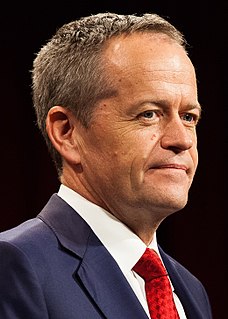
A leadership election was held in October 2013 to select Kevin Rudd's replacement as leader of the Australian Labor Party and Leader of the Opposition. Bill Shorten was elected party leader, and Tanya Plibersek was later confirmed as deputy leader.

The history of the Australian Labor Party has its origins in the Labour parties founded in the 1890s in the Australian colonies prior to federation. Labor tradition ascribes the founding of Queensland Labour to a meeting of striking pastoral workers under a ghost gum tree in Barcaldine, Queensland in 1891. The Balmain, New South Wales branch of the party claims to be the oldest in Australia. Labour as a parliamentary party dates from 1891 in New South Wales and South Australia, 1893 in Queensland, and later in the other colonies.

The Australian Labor Party , commonly known as South Australian Labor, is the South Australian Branch of the Australian Labor Party, originally formed in 1891 as the United Labor Party of South Australia. It is one of two major parties in the bicameral Parliament of South Australia, the other being the Liberal Party of Australia.
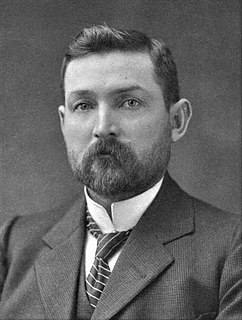
The Watson Government was the third federal executive government of the Commonwealth of Australia. It was led by Prime Minister Chris Watson of the Australian Labor Party from 27 April 1904 to 18 August 1904. The Watson Government was the first Labor Party national government in both Australia and in the world. Watson was aged just 37 when he became Prime Minister of Australia, and remains the youngest person to have held the post.

The United Australia Party (UAP) held a leadership election on 9 October 1941, following the resignation of Robert Menzies on the same day. Billy Hughes was elected as his replacement.

The Australian Labor Party held a leadership election on 16 May 1922, following the death of Frank Tudor. The party elected Matthew Charlton as its new leader.

The Australian Labor Party held a leadership spill on 8 July 1913, following the party's defeat at the May 1913 federal election. Andrew Fisher was re-elected to the leadership, defeating William Higgs. It was the first occasion on which a sitting leader had faced a challenge.

A leadership election was held in May 2019 to determine the successor to Bill Shorten as leader of the Australian Labor Party and Leader of the Opposition. Shorten announced his pending resignation on 18 May, following Labor's surprise defeat in the 2019 federal election. The leadership was confirmed unopposed; Anthony Albanese was elected as Leader, with Richard Marles elected Deputy Leader.


